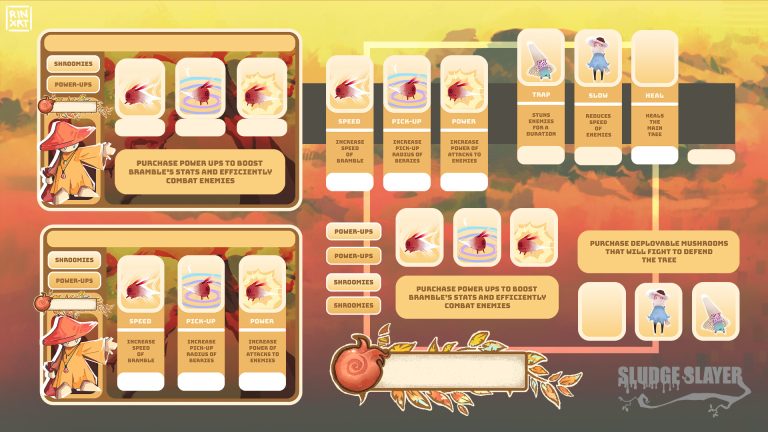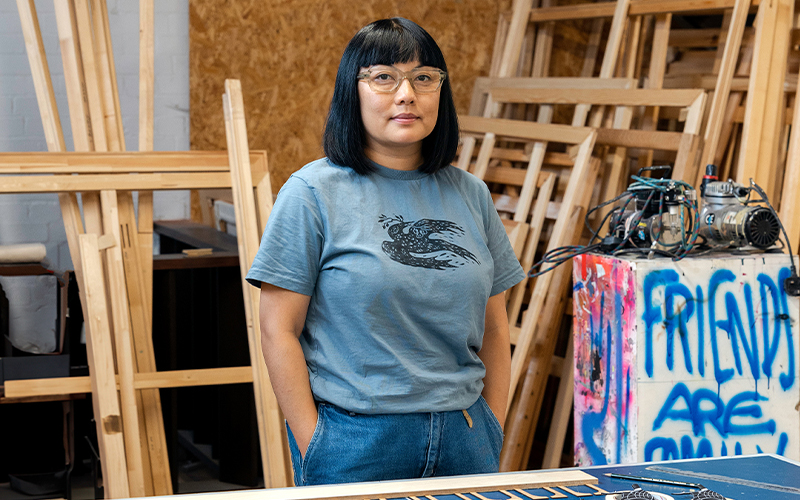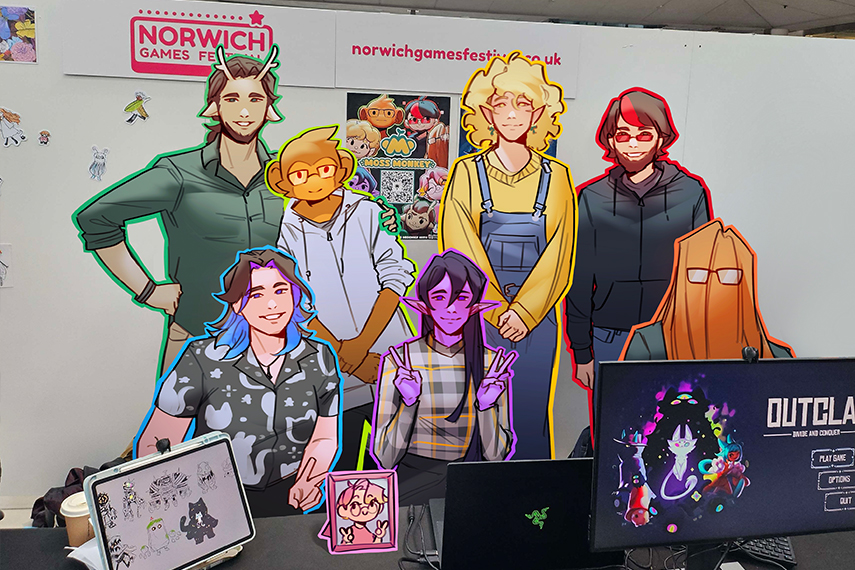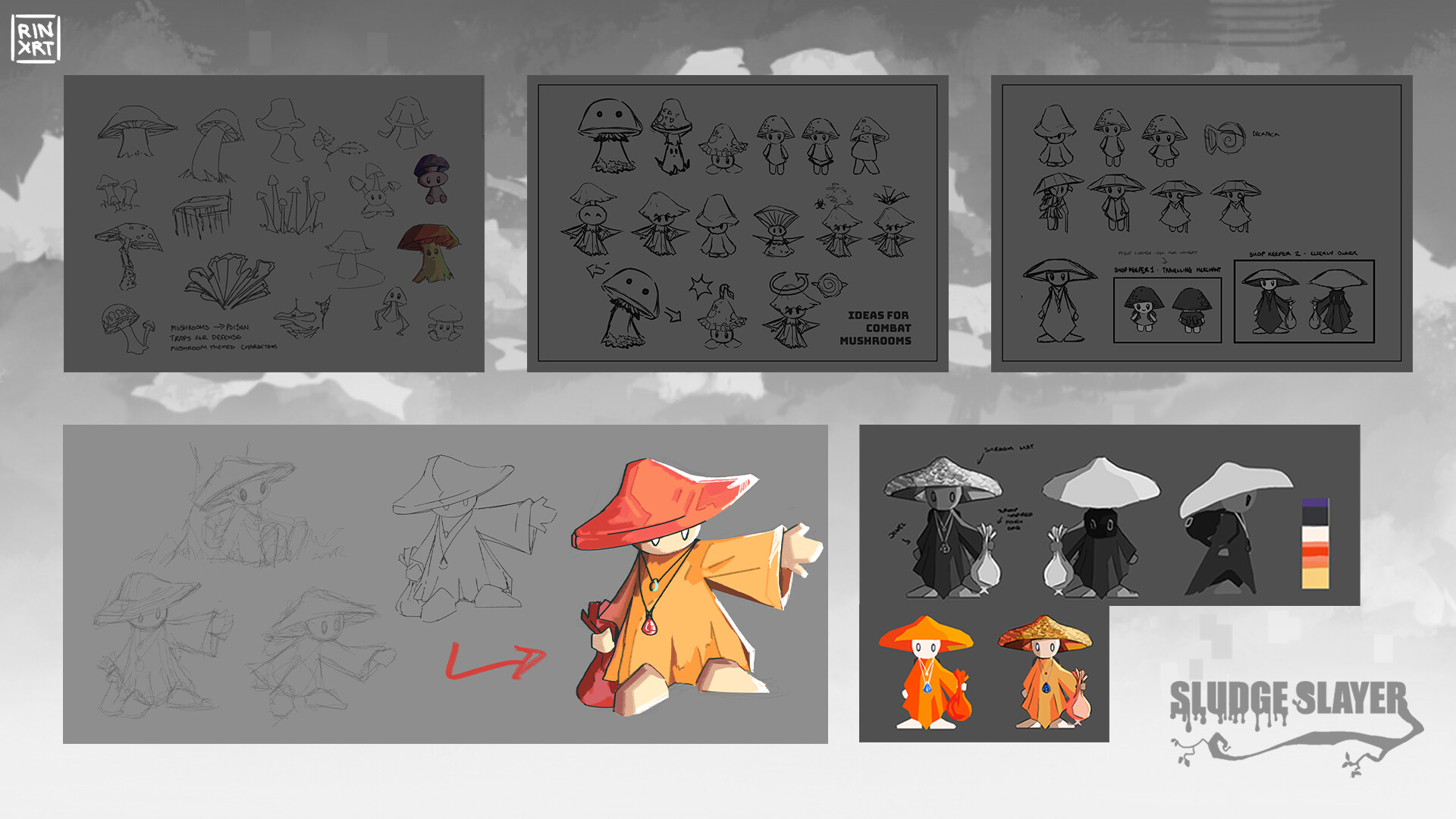What is a Norwich Uni Game Jam?
BSc (Hons) Games Development student Andy Dalaimo takes us inside one of Norwich University of the Arts’ Game Jams.

Our Game Jams are a break neck game development task where students have just one week to create a playable game from scratch.

Still from game ‘Sludge Slayer‘
Game Jams are a foreign, if not treacherous, concept to someone who has never participated in one before. The idea is to gather a group of artists and developers together, give them a brief and see if they can make a fully fledged game within a set window of time.
As games students, we participate in many Game Jams during the year. They are an invaluable way of squeezing what can be weeks of learning and experience into just a few days.
On this occasion, the Jam took place over the span of five days, and students were placed in groups of seventeen people. Each group contained a mix of second and third year students, and represented a range of specialities. The Jam was a week full of challenges and a tonne of learned experiences.
Day 1
We discovered our groups the day before the jam, and this is where the challenge really starts. In that crucial time before the briefing, teams get to know each other, form solid lines of communication and lay out some expectations and leadership roles.

On the first official day, the theme was revealed by the Games staff along with a small presentation to get us started. The theme: Regeneration. Immediately the team was buzzing with ideas about what kind of game could fit this theme, and what would be possible in 5 days. This frenzy of ideation felt amplified with so many people in the group trying to get their ideas across. It immediately became clear that the first major challenge was just how many people was in this group for a relatively short game jam.
After an hour or so of discussion, we settled on a rough direction: a real-time tower defence game where the player would defend a sacred tree from baddies, all while replanting and revitalising the forest around them. We broke into specialism-focused groups to discuss game plans.

User interface design for the in game shop by Erin Curtis
I was in a leadership position looking after the developers, and this meant outlining a guide of development processes to facilitate efficient collaboration. We had 5 developers in our group, so setting up processes early would alleviate software issues later in applications like GitHub (a version control software allowing multiple developers to work on one project).
After discussing what everyone felt comfortable with tackling first, we doled out roles and began to work. I decided to tackle more of the backend game systems first, such as the in-game economy, player upgrades, win/loss states and UI interactions. It was also important for me to be available if any of the other developers needed support.
Day 2
On Day 2 we were down to about six people working on campus; this is expected as some people are more comfortable to work from home, do not want to pay for the travel into the city, or understandably have other things going on. I should state that Game Jams are an optional torture!

Of course this brings a new set of challenges communicating through online pipelines. For myself, I found this quite difficult as it seemed communicating online, while trying to get work done at the same time, was very difficult. I was in a lead position, which meant I would have to manage my time better between my own development responsibility and lead/support roles.
Most of my development on this day was spent coding some core “Classes” for the other Devs to use. Put simply, this means building some of the logic, rules, and properties that make up the game world. Can the player jump? How high can they jump? All these need to be explicitly defined for the game to function properly.
Day 3
‘Are we going to get this finished on time?’ This phrase is often uttered at this point in a Game Jam. Half way through, the real horror of Game Jams is scope creep. With such a large group, ideas were plentiful. Developers made up just 5 out of the 17 people in the group. This meant that it was up to us as developers to firmly communicate with the rest of the team what was possible for us to achieve in that time.

Tree asset in place including set dressing for level
It was not all negative though, progress really became visible as we started adding some of the artists’ work into the project. The level design was really taking shape. The player felt good to control and the projectile shot from the player was working. Waves of enemies could be shot at. And from my end, the in-game economy was functional, and the player could start using some of the upgrades.
Day 4
On arrival in the morning, we were one day before submission (yikes!) and a few hours before submitting a playable demo. On top of that, a few features were not in the game. Namely, the power ups the player could use and the Enemy AI, which was still not fully functional.

Luckily a couple of key features were finished and then some. Specifically, the feature of the player planting trees to regenerate the forest and subsequently trigger a win state. And lastly, the UI design for the title screen, pause screen, and upgrade screen were all finished and ready to be added to the project.
Still, time flew by and before I knew it, it was just myself and 2 other team members staying until 9pm, getting as much as possible finished before the final morning of practical time the next day.

Designs for shop keeper character by Erin Curtis
Day 5
The final morning leading up to submission was really a fever dream. I hardly slept the night before thinking about my plan of action when I arrived on campus. Final polishes, bug fixes, and a lofty attempt at adding a tricky last-minute feature. I gave myself an hour to finish it.
So, while everyone else went on with making a trailer, polishing up the level, capturing gameplay footage, and printing out a poster, I put in my headphones and got to work. Somehow I had it working in about 20 minutes. Sometimes after banging your head on a problem for hours the night before, all that is needed is a little time away and the solution becomes obvious.
Aside from some last minute-hiccups we had a fully functioning game that we really felt proud of. It looked tremendous; the artists really took the theme and ran with it, and I was proud of all the challenges the Dev team faced and were willing to sit with and learn through. As a team we set ourselves an ambitious scope for the project, and we managed to hit almost all of the goals we set for ourselves. It was a very successful Game Jam, and I left the experience with a whole new set of collaborators I wish to work with in the future.
To find out more about this Game Jam and Andy’s other projects, take a look at his portfolio.
Sludge Slayer Credits
Concept Art: Albert Moisan, Joel Maston-Shea, Leonardo Scalia, Alex Khanagha, Emily Ash, Erin Curtis, Jarvey Southorn.
Asset: Alice Whitmarsh, Viky Shen, Abigail Ballard, Esti Boland, Louis Maxted, Ashley Holmes.
Development: Andy Dalaimo, William Fuller, Ryan Drewry, Aaron Lobuczek, Jack Kean
Gallery
Other interviews
-

In conversation with Norwich’s newest lecturers in Marketing and Business Management
-

Dear future international students – Diya Vaya, BA (Hons) Film and Moving Image Production
-

Inside Interchange Week with Stokely Howard of Trendy Grandad
-

Shape Shift Converse Rework: Authentic co-creation of art in mental health settings
-

In conversation with Gabriella Mason, BA (Hons) Illustration
-

In conversation with Cassie Muskett, BA (Hons) Graphic Communication
-

Embracing AI in Textile Design: A journey of creativity and collaboration
-

In conversation with: Alice Lee, BA (Hons) Illustration lecturer
-

In conversation with: Lucien Kelman, BA (Hons) Animation
-

In conversation with: Sam Butler, BA (Hons) Graphic Communication
-

In conversation with: Tracey Lin, BA (Hons) Architecture student
-

In conversation with: Iz Head, BA (Hons) Games Art and Design







